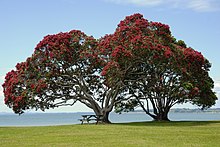Pōhutukawa
| Pōhutukawa | |
|---|---|
 |
|
| Pōhutukawa trees | |
| Scientific classification | |
| Kingdom: | Plantae |
| (unranked): | Angiosperms |
| (unranked): | Eudicots |
| (unranked): | Rosids |
| Order: | Myrtales |
| Family: | Myrtaceae |
| Genus: | Metrosideros |
| Species: | M. excelsa |
| Binomial name | |
|
Metrosideros excelsa Sol. ex Gaertn. |
|
| Synonyms | |
|
|
Metrosideros excelsa, with common names pōhutukawa, New Zealand pohutukawa,New Zealand Christmas tree,New Zealand Christmas bush, and iron tree, is a coastal evergreen tree in the myrtle family, Myrtaceae, that produces a brilliant display of red (or occasionally orange, yellow or white) flowers made up of a mass of stamens. The pōhutukawa is one of twelve Metrosideros species endemic to New Zealand. Renowned for its vibrant colour and its ability to survive even perched on rocky, precarious cliffs, it has found an important place in New Zealand culture for its strength and beauty and is regarded as a chiefly tree (rākau rangatira) by Māori. The blossom of the tree is called kahika.
The generic name Metrosideros derives from the Ancient Greek metra or "heartwood" and sideron or "iron". The species name excelsa is from Latin excelsus, "highest, sublime". Pōhutukawa is a Māori word. Its closest equivalent in other Polynesian languages is the Cook Island Māori word po'utukava, referring to a coastal shrub with white berries, Sophora tomentosa. The -hutu- part of the word comes from *futu, the Polynesian name for the fish-poison tree (Barringtonia asiatica), which has flowers similar to those of the pōhutukawa.
The pōhutukawa grows up to 25 metres (82 ft) high, with a spreading, dome-like form. It usually grows as a multi-trunked spreading tree. Its trunks and branches are sometimes festooned with matted, fibrous aerial roots. The oblong, leathery leaves are covered in dense white hairs underneath.
...
Wikipedia
